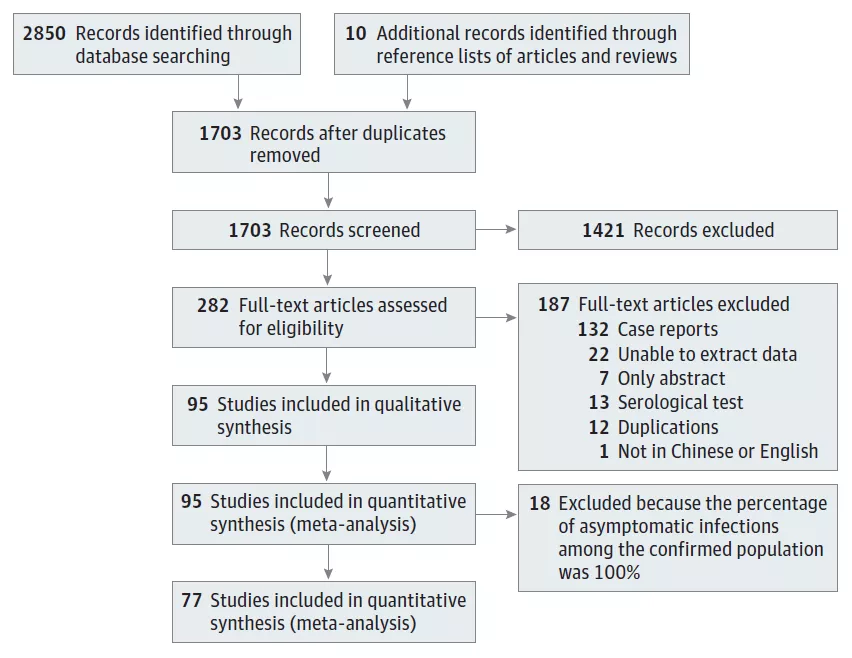Why is the COVID-19 epidemic difficult to prevent and control?
- Normal Liver Cells Found to Promote Cancer Metastasis to the Liver
- Nearly 80% Complete Remission: Breakthrough in ADC Anti-Tumor Treatment
- Vaccination Against Common Diseases May Prevent Dementia!
- New Alzheimer’s Disease (AD) Diagnosis and Staging Criteria
- Breakthrough in Alzheimer’s Disease: New Nasal Spray Halts Cognitive Decline by Targeting Toxic Protein
- Can the Tap Water at the Paris Olympics be Drunk Directly?
Why is the COVID-19 epidemic difficult to prevent and control?
Why is the COVID-19 epidemic difficult to prevent and control? Peking University research shows that up to 40% of people infected with the COVID-19 are asymptomatic.
At 0:00 on December 23, 2021, Xi’an City pressed the pause button, and all communities and units in the city implemented closed management, and all residents did not go out unless necessary.
On December 25 and 26, there were more than 150 newly confirmed cases in Xi’an in a single day for two consecutive days.
The press conference held in Xi’an mentioned that nucleic acid testing in the next few days may report more new cases.
Under such strict epidemic prevention and control in our country, small-scale epidemics still appear from time to time, which also makes us realize that the prevention and control of the COVID-19 epidemic is not easy.
At the beginning of the outbreak, people infected with the COVID-19 often have symptoms such as fever, headache, and difficulty breathing.
Over time, the proportion of asymptomatic infections has increased significantly, which undoubtedly makes the prevention and control of the COVID-19 epidemic more difficult.
Determining the current proportion of asymptomatic infections among those infected with the COVID-19 is of great significance to the prevention and control of the epidemic.
Recently, the School of Public Health, Peking University Liu Min team of professors in JAMA sub-Journal JAMA Network Open a speech entitled: , Ltd.
Free Join Percentage of asymptomatic of SARS-CoV-2 Infections Among Tested at The Population and the Individuals With Confirmed COVID-19 Diagnosis: A Systematic Review and Meta-analysis paper.
The research team analyzed 95 papers involving the proportion of asymptomatic infections of the COVID-19 (these papers involved 30 million people per month) and found that the proportion of asymptomatic infections among the COVID-19 infections may exceed 40% .
Asymptomatic infection refers to a positive nucleic acid test, that is, they are infected with the new coronavirus, but they do not show symptoms of response.
More importantly, asymptomatic infected people can also spread the COVID-19 to others, and because they are asymptomatic, they The possibility of spread is often greater.
In order to further confirm the proportion of asymptomatic infections of the COVID-19, Liu Min’s team first found 2,860 papers involving asymptomatic infections of the COVID-19, and then screened 95 papers related to the proportion of asymptomatic infections, which involved 29,776,306 people. Among these 95 papers, 18 papers are all subjects of asymptomatic infection.

Through further analysis of these 95 papers, the research team found that a total of 29,776,306 people received nucleic acid testing, of which 11,516 were asymptomatic infections, accounting for 0.25% of the total number of people tested.
Among them, the proportion of asymptomatic infections among the population in nursing homes was 4.52%, the proportion of asymptomatic infections among air or cruise passengers was 2.02%, and the proportion of asymptomatic infections among pregnant women was 2.34%.
The research team further analyzed the proportion of asymptomatic infections.
Among the 95 papers, 18 only studied asymptomatic infections.
Therefore, the research team removed these 18 papers and further analyzed the remaining 77 papers.
In this paper, a total of 19,884 people were confirmed to be infected with the COVID-19 through nucleic acid testing, of which 11,069 were asymptomatic infections, and the proportion of asymptomatic infections was as high as 40.50% .
Among the infected, pregnant women had the highest asymptomatic ratio, reaching 54.11%, air or cruise passengers 52.91%, and nursing homes 47.53%.
Thanks to strict epidemic control, some countries has well controlled the development of the epidemic very early, and the COVID-19 epidemic abroad is still spreading, so some countries is facing great pressure from overseas imports.
This study shows that the proportion of asymptomatic infections among the confirmed patients of aviation and cruise passengers is very high, exceeding 50%.
This also reminds us that it is necessary to conduct nucleic acid testing and isolation for domestic personnel from abroad. It is very important to prevent community spread.
In general, this large-scale statistical analysis shows that among the people tested, the proportion of asymptomatic infections is 0.25%, and among the people diagnosed with COVID-19s, the proportion of asymptomatic infections is as high as 40.50% .
This highlights the difficulty of prevention and control of the COVID-19 epidemic, and also highlights the need for comprehensive nucleic acid screening when an epidemic occurs.
Asymptomatic infections also carry the new coronavirus, and the viral load is equivalent to that of symptomatic infections, and because they are asymptomatic, they are often found later and the risk of transmission is greater.
Therefore, for asymptomatic infections, the same isolation and close contact tracking are required for symptomatic infections.
Paper link :
https://jamanetwork.com/journals/jamanetworkopen/fullarticle/2787098
Why is the COVID-19 epidemic difficult to prevent and control?
(source:internet, reference only)
Disclaimer of medicaltrend.org




